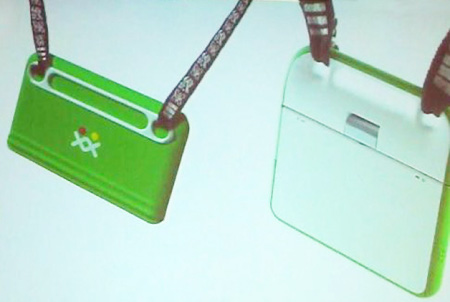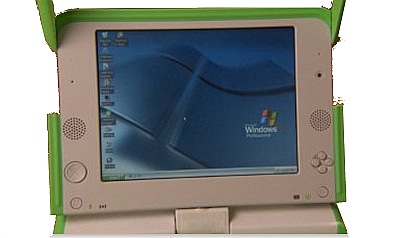OLPC partners with Amazon, ITU
Sep 5, 2008 — by Eric Brown — from the LinuxDevices Archive — 6 views Amazon will sell One Laptop Per Child (OLPC)'s Linux-compatible XO notebook starting in November, says a news story. The story also says OLPC is partnering with the International Telecommunication Union (ITU) to help distribute the notebooks, and the next-generation XO-2 will ship in 1Q 2010.
Amazon will sell One Laptop Per Child (OLPC)'s Linux-compatible XO notebook starting in November, says a news story. The story also says OLPC is partnering with the International Telecommunication Union (ITU) to help distribute the notebooks, and the next-generation XO-2 will ship in 1Q 2010.
(Click for larger view of XO-2 mockup)
Amazon will apply its considerable product fulfillment capabilities to help the non-profit OLPC re-launch its stalled Give One Get One program for the notebooks, says a IDG News Service story by Dan Nystedt. In the story, Matt Keller, OLPC's director of Europe, Middle East and Africa (EMEA), was interviewed about the Amazon deal and the ITU partnership.
Keller was quoted as saying that the tablet-like, touchscreen-enabled XO-2 version of the notebook will ship in the first quarter of 2010. Mock-ups of the XO-2 (pictured above and below) were first displayed in May. Intended to reflect Alan Kay's original Dynabook design developed back in 1968, the device is smaller than the XO-1 and consumes only one Watt.

XO-2 (left) and XO-1 (right)
(Click to enlarge)
 Hearkening back to the Dynabook: OLPC's XO-2 mock-up (Source: OLPC wiki) (Click to enlarge) |
The XO-2 will dispense with the the keyboard and touchpad and depend solely on dual 16×9-proportioned, sunlight-readable touchscreens, says OLPC. The device can be used as a standard notebook, with one screen revealing a keyboard-like touchscreen interface, or it can be used in e-book mode or as a dual-screen mode for collaborative use and games. The goal is to deliver the device at a volume price of $75 to large educational buyers.
New life for Give One Get One
OLPC's Give One Get One program was announced last September as an alternative to OLPC's standard distribution approach, which is to sell the partially subsidized XO-1's directly to the governments of developing countries with the promise that they will give them away to poor children. Give One Get One, on the other hand, was set up so that any customer could pay for two of the XOs, with one being sent to the buyer, and the other donated to a child in a developing country.
Due to the program's popularity, plus manufacturing delays and the fact that the small OLPC outfit was unprepared to fulfill orders on such a scale, the program was quickly discontinued. In fact, relatively few customers actually received the notebooks. The new program will be implemented by Amazon on a trial basis aimed at the holidays, with the sales lasting until at least the end of the year, says the IDG story.
Meanwhile, the partnership with the United Nations's ITU group, whose goal is to provide everyone in the world with access to information technology and communications by 2015, is intended both to encourage governments to pony up the cash for large-scale shipments, as well as find new avenues to distribute the notebooks. According to the article, OLPC and the ITU “plan to combine efforts to spread XO laptops to kids around the world, including promotional efforts, sharing contacts in government, industry, non-governmental organizations and others.” Additional plans are said to include fund-raising to further reduce the cost of the notebooks.
OLPC's long and tumultuous road
Championed by MIT's Nicholas Negroponte, and manufactured by Quanta of Taiwan, the Linux-based XO began to ship at the end of last year. Initial units featured an AMD Geode LX-700 processor clocked at 433MHz, an integrated graphics controller driving a 7.5-inch, 1200 x 900 screen, 256MB of RAM, and 1GB of flash storage. The devices also offer WiFi-based mesh networking.
Over the last year the XO's price rose to twice the initially touted $100, leading governments to back off of plans to make high-volume purchases. So far, only about a half million notebooks have shipped, which is considerably less than the ambitious plans to ship millions by now.
In January, it was revealed that OLPC was actively collaborating with Microsoft on delivering a Windows XP version of the XO. This news did not go down well with many of the Linux faithful in the organization, who were further outraged when Intel joined the OLPC board and was accused of undercutting OLPC sales overseas in favor of its own, similarly targeted, Linux-compatible Classmate PC. (Intel quit the board in early January.) XO developers were also concerned with the poorly implemented Give One Get One campaign, as well as the decreasing focus on developing Linux-based educational software.

Windows XP version XO-1 mockup
Before the May announcement that OLPC had finally signed a deal with Microsoft and had developed a prototype Windows XP version of the XO, project co-founder Walter Bender and other contributors to the Sugar user interface left the group. They went on to found a project called SugarLabs, which is committed to developing open source GNU/Linux-based educational software.
Despite its troubles, which include reports that the XP version does not work well, OLPC's XO is largely credited for having started the recent boom in small-scale netbooks. As seen in our Linux Netbook Showcase, the netbook category is one of the fastest growing areas in computer sales. The segment has not only improved the fortunes of Linux, but has contributed to the rebirth of Windows XP.
The IDG News Service story on OLPC has been spread out over several IDG publications, with separate stories devoted to Amazon, the ITU, and the XO-2.
Meanwhile, as Negroponte and other MIT geniuses involved in the OLPC project continue to struggle to deliver a “$100 laptop,” the project's original goal, a consumer electronics manufacturer in Shenzhen, China, known primarily for its digital photo frames has apparently succeeded in doing just that.
This article was originally published on LinuxDevices.com and has been donated to the open source community by QuinStreet Inc. Please visit LinuxToday.com for up-to-date news and articles about Linux and open source.